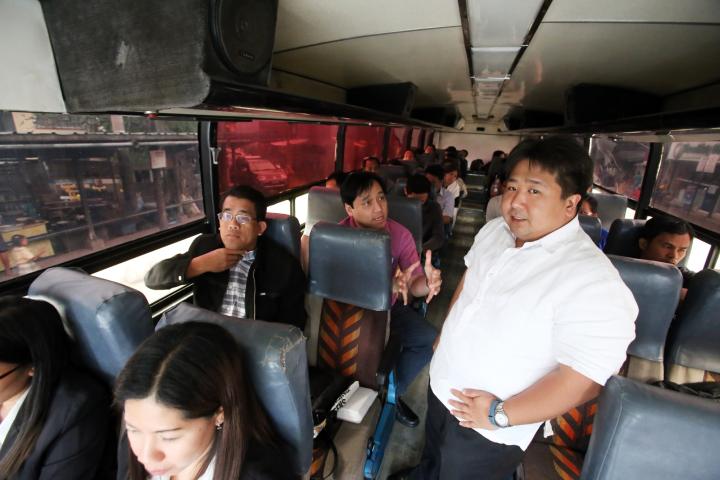
Rafael Yap (right) Bus Rapid Transit (BRT) System project director explains the routes to Winston Ginez, Land Transportation Franchising and Regulatory Board (LTFRB) chairman (seated left) and LTFRB board member Antonio Inton (seated behind Ginez) during an ocular inspection of the routes on board a Kaohsiung bus. (CDN PHOTO/ JUNJIE MENDOZA)
Cebu City Hall’s Bus Rapid Transit (BRT) group accompanied officials of the Land Transportation Franchising and Regulatory Board (LTFRB) in an ocular inspection of the BRT routes yesterday.
Rafael Yap, BRT project chief along with LTFRB chairman Winston Ginez and LTFRB members Ronaldo Corpuz and Antonio Enrile Inton, rode a Kaohsiung bus to inspect the BRT routes starting from Natalio Bacalso Avenue to Osmeña Boulevard, to Banilad and Talamban.
Yap said he expected the bus to cover all BRT routes in one hour and 30 minutes.
Due to the light traffic, they covered the routes in one hour and five minutes.
“We will continue to conduct road inspections to finalize the route infrastructure adjustments,” Yap told Cebu Daily News.
He said even with the increase in the number of private vehicles, the BRT remains a viable public transportation system.
Convenient
Yap said the BRT project is not the direct solution to traffic congestion but it can help reduce the riding public’s dependence on passenger jeepneys and give more road space to private vehicles.
He said his office is still validating the locations of the terminals and stations that are convenient and suitable to the public.
There will be 180 to 190 BRT units running in Cebu City once the project is completed.
LTFRB chairman Winston Ginez said their office will issue an order to their regional office to hold a dialogue with transport groups and drivers on the BRT project.
“We need to do this because there will be social impacts upon the BRT’s implementation,” Ginez said.
A workshop and dialogue was held among stakeholders on the BRT project yesterday.
The proposed BRT route will use the center island of Osmeña Boulevard for dedicated bus lanes and passenger terminals.
It will also compel buses to use three flyovers including the Banilad-Talamban flyover during peak hours.
Detailed engineering studies for the BRT project are expected to start early this year and will take eight months to complete.
The P10.6 billion BRT project is expected to be operational by 2017.